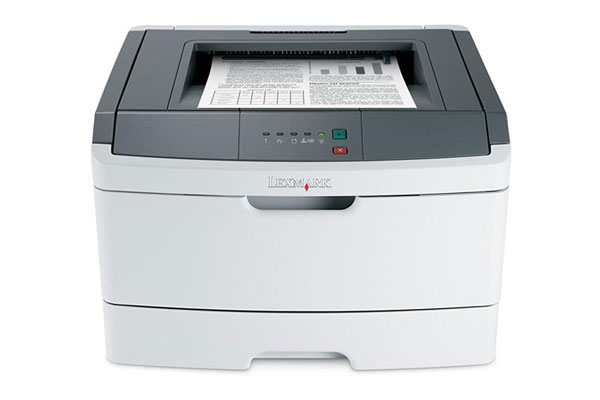Lexmark E260dn review
Sometimes a small, inexpensive networked printer makes more sense than using the monster printer down the hall. We examine this affordable unit from Lexmark.

A mid-range, mono laser printer with a good turn of speed, particularly when printing duplex. Cost per page is reasonable, though we have seen better, and print quality is also better than average. Maintenance is simple and shouldn't be too frequent, so the printer could easily be kept running by non-expert personnel.
The mono laser is still the stalwart office printer for internal and much external documentation and Lexmark has always been a key player in this field. Its E260DN is a mid-range device, for SOHO or small workgroups, though it still offers a good turn of speed and duplex print.
With Lexmark's new styling, the dark grey and cream machine is pretty cuboid, with the front edge chamfered off for a control panel and a slight bow to the front panel, to ease its lines. The first thing you notice is a thin wire arm arcing across the top of the printer, which keeps printed pages in place as they're fed out. It looks flimsy and not particularly attractive.
The main paper tray holds 250 sheets and you can fit an optional second tray underneath the printer to bring the overall capacity up to 800 sheets. In fact, that should be 801, as the front panel folds down to reveal a single-sheet, multi-purpose feed. Fold down the front and top panels and you have access to the two-piece drum and toner cartridge. The drum only needs replacing every 30,000 pages, while the toner cartridge is good for 3,500.
The control panel is very straightforward, with five indicators, an illuminated start button and a job cancel button just below it. There's no status display on the printer, but the leds cover all the main indications, such as paper jam, paper out and low toner.
At the back are sockets for USB 2.0, Ethernet and a legacy parallel port, so this machine should be able to fit into older installations as a replacement device with minimal setup changes. Software installation is simple, and consists of a network monitoring tool and drivers for PCL 6 and Postscript Level 3, both in emulation. The driver dialog is well laid out and includes most of the common features, such as printing watermarks (though not overlays) and multiple pages per sheet.
Fitting the drum and toner cartridge is as simple as folding down the entire front cover and slotting in the two-piece unit, until it clicks into place. The toner cartridge itself clips into the cradle of the photoconductor drum and with a few minutes training, it can be done by anybody in a small business or workgroup.
Lexmark claims a print speed for this machine of 33ppm, but unless you can duplicate the exact measurement environment, you're unlikely to see this speed in normal use. Our five-page black text print took 19 seconds, giving a typical print speed in normal mode of just under 16ppm. While this is well short of the headline rate, it's still a very reasonable rate for this class of SOHO laser printer.
Get the ITPro daily newsletter
Sign up today and you will receive a free copy of our Future Focus 2025 report - the leading guidance on AI, cybersecurity and other IT challenges as per 700+ senior executives
-
 Cleo attack victim list grows as Hertz confirms customer data stolen – and security experts say it won't be the last
Cleo attack victim list grows as Hertz confirms customer data stolen – and security experts say it won't be the lastNews Hertz has confirmed it suffered a data breach as a result of the Cleo zero-day vulnerability in late 2024, with the car rental giant warning that customer data was stolen.
By Ross Kelly Published
-
 Women show more team spirit when it comes to cybersecurity, yet they're still missing out on opportunities
Women show more team spirit when it comes to cybersecurity, yet they're still missing out on opportunitiesNews While they're more likely to believe that responsibility should be shared, women are less likely to get the necessary training
By Emma Woollacott Published
-
 OpenAI wants developers using its new GPT-4.1 models – but how do they compare to Claude and Gemini on coding tasks?
OpenAI wants developers using its new GPT-4.1 models – but how do they compare to Claude and Gemini on coding tasks?News OpenAI says its GPT-4.1 model family offers sizable improvements for coding, but tests show competitors still outperform it in key areas.
By Ross Kelly Published